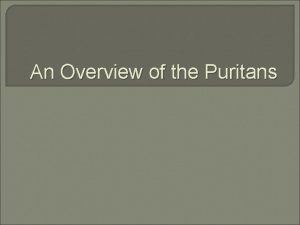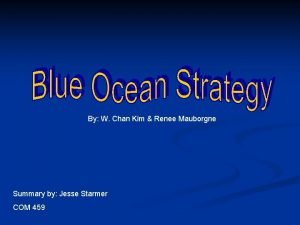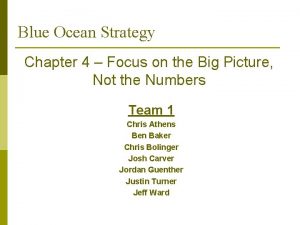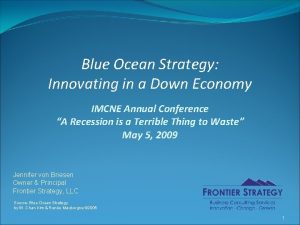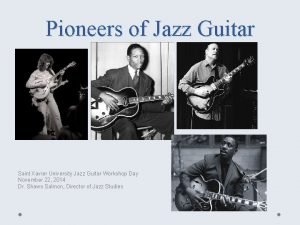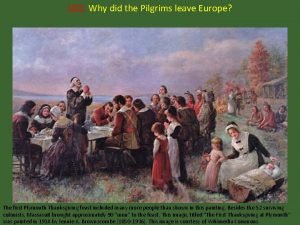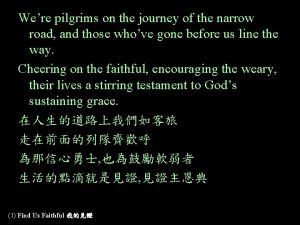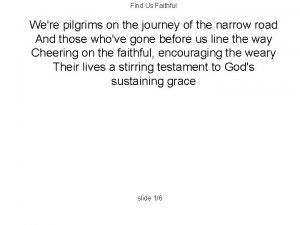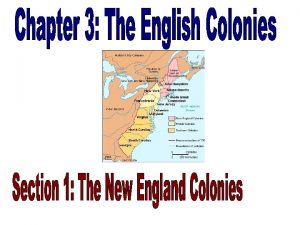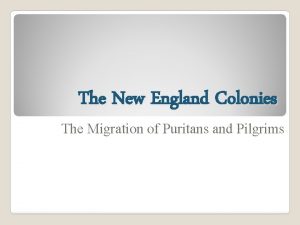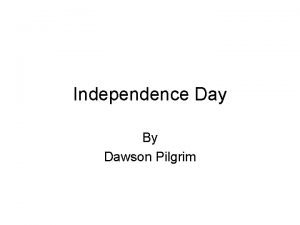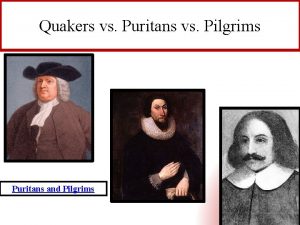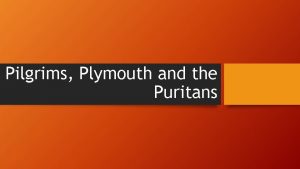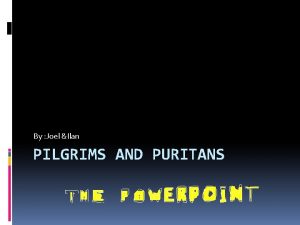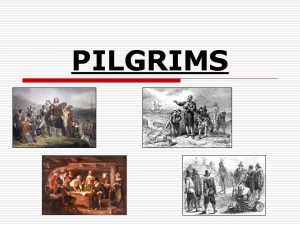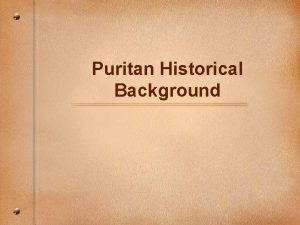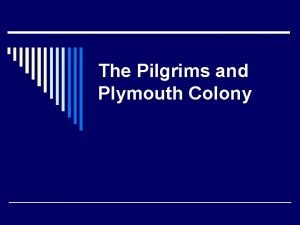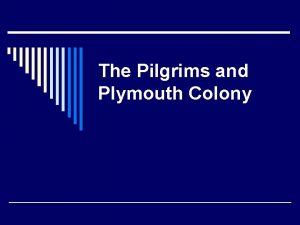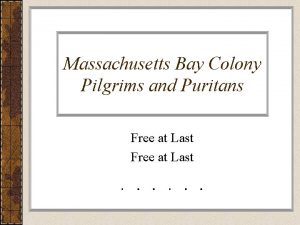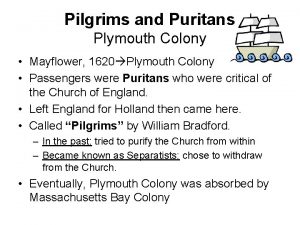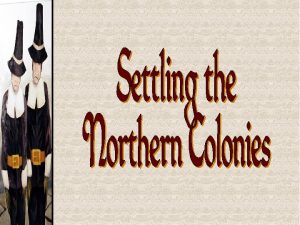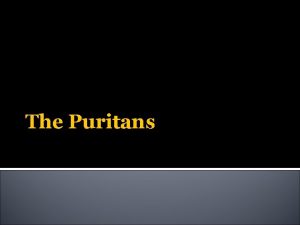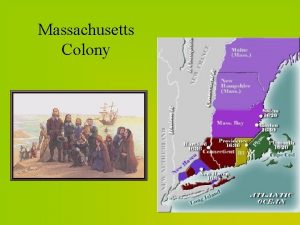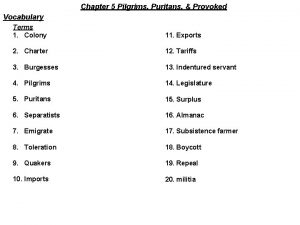Pioneers Pilgrims and Puritans Chapter 2 Colony Florida

















- Slides: 17

Pioneers, Pilgrims and Puritans Chapter 2

Colony Florida New Mexico Virginia New France New Netherland Plymouth Maine St. Kitts, Barbados Massachusetts Bay Trading Maryland Rhode Island Connecticut New Haven New Hampshire Founder Pedro Menendez de Aviles Juan de Onate Virginia Company France Dutch West Indian Company Pilgrims Sir Ferdinando Gorges European migrants Mass Bay Company Date 1565 1598 1607 1608 1614 1620 1622 1624 1630 Basis of Economy Farming Livestock Tobacco Fur Trading Farming, Fishing Sugar Farming, Fishing, Fur Cecilius Calvert Roger Williams Thomas Hooker Mass migrants 1634 1635 1636 1638 Tobacco Farming, Fishing

New France • By the middle of the 17 C, France had founded Quebec and Montreal, outposts that served as that nation’s claim to what is now Canada. Fur becomes the new calling for the France in Northern US and Southern Canada. The usual explanation for Indian involvement in the fur trade is that the European hardware and other trade items were immediately perceived by the Stone Age Indian as being far superior in their utility to his primitive technology and general material culture. Without pausing to worry over scruples, so the conventional wisdom goes, the Indian went on the warpath against the beaver, otter, marten, muskrat and so forth,

Calvin Martin and Keepers of the Game But, consider this, the traditional religious belief system had already been undermined by the time these Indians began participating in the organized fur trade and that the undermining process consisted, in part, of nullifying the traditional sanctions of to wildlife overkill when Europeans first penetrated the continent. For years scholars have claimed for that North American Indians had a special fondness for Nature. Did we answer the question to Native American involvement in western terms? Did the Indian really become avaricious like his European counterparts or was something else involved. As an example lets look at the Micmac contact with the French. Shortly after contact, an epidemic spreads throughout the entire region and thousands of Micmac die. These Indians blamed wildlife for their diseases precisely because they were the source of their many ailments. There may have been something of a mythological and spiritual rational as well. Was this a spiritual war? Never before had the Indians suffered this kind of illness or diseases of such magnitude and severity. Could this be a conspiracy of the beasts of the land? The fur-trade must be reconciled to the super-naturalistic world view of the Indian if it is to be seen as a two-dimensional experience. The chance to make his life more convenient (pots, knives, blankets, goods) appealed to him and he used a long-standing war with Nature to get just that.

New Netherland In 1614, the Dutch established a post near present Albany, New York. The presence of the Dutch traders helped spawn competition, and war, among the various tribes. Although the French and Dutch seemingly settled in the same area, they rarely fought. Their goals were different. The French settled with money and religious conversion as goals; the Dutch brought families and were out to make a fortune. They had different contacts. The French sold furs, the Dutch were the bankers and entrepreneurs. However, the Indians that traded primarily with the Dutch, the Iroquois, and the Hurons who traded primarily with the French did war with each other. Between the war and European disease, the Huron population was severely decimated.

English Reformation Roughly begins in 1517 when Martin Luther nails is 95 theses on the door of the church. Indulgences Church Money Henry’s Weddings and Divorces The English Reformation, which King Henry VIII initiated in 1533, set the stage for large numbers of English dissenters to leave their homeland. He desired to divorce and marry another in 1527. Thomas More disagreed. Lost his head. Henry dissolved his relationship with the Catholic Church and established himself as the head of the English church in 1534 having married Anne Bolyn the year before and excommunicated from the Roman Catholic

Puritans, Social Change and Joint-Stock Companies Conflict between the Stuart monarchs and dissenters called Puritans caused thousands to settlers to leave England in the 1630 s. In addition to the religious transformation in England, dramatic social and economic changes encouraged migration to the New World. Joint-Stock Companies: English investors established joint-stock companies to finance early colonization projects. These forerunners of modern corporations enjoyed limited success in providing the vast long-term investment funds necessary for colonization.

Founding of New England Puritans’ Beliefs Puritans believed in an omnipotent God who had predestined some people for salvation and some for damnation. Followers of John Calvin never really knew if they were saved. Calvin in 1536 published his Institutes of the Christian Religion that put him in the forefront of Protestant revival and revision Founding of Plymouth Separatists, who wanted to leave the Church of England, arrived in America in 1620. Founding of Massachusetts Bay When Charles I ascended to the throne in 1625 his anti-Puritan policy led thousands of Congregationalists to leave England for America. 1630 -40 the Puritans define their Wilderness Zion, their City Upon a Hill The policy established, structure of the central government at Boston worked out, church member franchise established, county courts and towns established Not separatists like Pilgrims, self-governing churches, membership=visible saints, demonstrate receipt of grace—they carried the charter to the New World Governor John Winthrop, first elected governor of Massachusetts Bay Colony in 1629, envisioned a communal society based on Christian charity that put the common good before the needs of the individual.

Founding of New England, Cont. Idea of a Covenant The concept of a covenant permeated Puritan society. This faith in mutual consent manifested itself in the colony’s political institutions. Puritans believed that God had made a covenant—that is, an agreement or contract—with them when they were chosen for their special mission to America. In turn they made a covenant with God that they would work together toward goals. However, you can see how whose goals and how those goals are defined would lead to controversy. education: Harvard founded (1636), town schools in 1647; clergy not permitted to hold public office New England Towns Puritan ideas influenced land distribution in the New England colonies. Massachusetts often gave land to groups rather than to individuals, grants that led to the growth of communities rather than to large personal holdings. Pequot War English migration into the Connecticut valley spawned conflict with the Pequot tribe. The Pequots were the go-between for the New England tribes and the Dutch in New Netherlands for trade. However, when the English arrive, the Dutch trade with their European counterparts, leaving the Pequot entirely out of the loop. From 1637 -1643 attacks by the Pequots and eventually neighboring tribes that joined the Pequots plagued New England. But, missionary activity was at an all-time low in that region and the emphasis placed on religion and God’s presence in English settlements furthered the interests of the colonists at the expense of the Native Americans.

Founding of Virginia Great difficulties beset Jamestown, the first permanent settlement in Virginia. In 1606 the first settlers of men and boys arrived in Jamestown. There are 144 of them. By 1608, however, only 38 of the original 144 are still alive. However, the biggest thing lacking in the colony was a government or sense of legal order. This was instituted by Captain John Smith in 1608, before the women came. However, he was there for only a short period and after he left a “starving time” occurred in Jamestown. This was a period of great suffering and trial for the early colonists. Within this period, 1609, women came to the colony and their

Powhatan Confederacy Jamestown survived largely as a result of aid from the Algonquian Indians, but problems arose between the Englishmen and members of the Powhatan Confederacy. The Powhatan Confederacy was a governmental hierarchy of 5 Algonquian tribes. The chief of the Indian confederacy was Powhatan who had a daughter named Pocahontas. The daughter of Powhatan (and thus a princess to the English) Pocahontas first met John Smith when she was twelve years old. She struck up a friendship with the Englishman, and for several years she helped the Jamestown colony survive by supplying the settlers with food. She also gave Smith information about her father’s policies, which had grown increasingly aggressive. Relations between the Indians and the colonists deteriorated into war, and in 1613 the English captured Pocahontas and held her hostage. While captive, she accepted Christianity, took the name Rebecca, and married John Rolfe. Powhatan consequently agreed to a tenuous peace settlement. The Virginia Company saw Rebecca as a public relations coup. She represented improved relations with Native Americans, which was important in attracting new settlers. She also proved that Indians could be “saved. ” They could be brought to the faith and civilized. Unfortunately, civilization had a high price. While traveling in England, Pocahontas contracted a disease and died in 1617.

Algonquian and English Cultural Differences The Indians and the Europeans had many differing views, but the Englishmen’s attitude of cultural superiority led to the greatest problems between the two peoples. The English thought that the Indians were lazy because they hunted. To the English hunting was a sport, not a means of survival. They looked upon the Indians’ “misuse” of the land as an abomination. Indians in Virginia continued to be a concern to English colonization. After Powhatan’s brother Opechancanough took over the confederacy, he recognized the encroachment of Europeans on his land, his religion and his way of life. In 1622 he attacked the colony and killed almost ¼ (347 people) of the colony. Virginia almost collapsed from this loss of life. But, in the next two years, reinforcements in the form of colonists, supplies and weapons arrived culminating in a battle with Opechancanough. He attacked the colonists in April of 1644 and was killed in battle. By 1646, what was left of the Powhatan Confederacy signed a treaty formally accepting subordination to English authority. The alliance crumbled after that and their efforts to resists European settlement ended.

Life in the Chesapeake: Virginia and Maryland Founding of Maryland Founded in 1632, mirrored Virginia in many ways. One important difference set Maryland apart: the colony tolerated all Christian faiths and therefore served as a haven for Catholics. Migrants to the Chesapeake Tobacco cultivation required a large labor force, a need met by bringing indentured servants to the colonies. Life for these migrants proved difficult, but opportunities existed for those who fulfilled their contracts. Indentured servitude and the “seasoning” process—a bout with disease (probably malaria) that usually occurred during their first summer in the Chesapeake area. In the early years, approximately 40 percent of the men did not live long enough to be free. Some of them deserted their post, were killed or jailed. Some left to live with Indians, but most continued in their service until it was paid off and then learned a skill or indentured longer to earn a savings so they could purchase their own land or business. Women who indentured were usually not allowed to marry until their indenture was over. Family life in the Chesapeake The predominance of males, the economic conditions, and high mortality rates in the Chesapeake led to fewer, smaller and shorter-lived families in Virginia and Maryland. Very imbalanced ratio of many women to men in the Chesapeake. Any eligible female was married. Chesapeake Politics A native-born elite with local ties and interest failed to emerge in Virginia and Maryland, leading to political instability.

New England the Chesapeake Compared Puritans developed a more heterogeneous and healthier population than did settlers in the Chesapeake, resulting in large, long-lived families. Family life in New England Big families, religious intolerance, and strict morality characterized life in New England. Roger Williams advocated Indian’s rights, separation of church and state, and religious tolerance. In 1635, he founded the town of Providence in what became Rhode Island. A separatist migrated to Mass in 1631 and was not able to practice his religion without persecution. He believed that the king of England had no right to give away land already occupied by Native Americans. He was banished from Mass in 1635 and founded Providence accordingly. Anne Hutchinson emphasized the covenant of grace and direct communication with God. Her ideas threatened Puritan religious orthodoxy and traditional gender relationships. A midwife and popular with the women of Boston. Puritans believed in some works, she believed in grace only. When she began holding women’s meetings to discuss the sermons given the previous Sunday and she questioned the right of salvation and the right of women to interpret the Bible for themselves, she was banished.

Other Colonies New Netherland becomes New York Charles gave his younger brother, the duke of York, claim to the are the Dutch had previously settled as New Netherland. The Founding of New Jersey The duke of York regranted much of his land to two friends, thereby limiting the geographical extent and economic growth of New York. Pennsylvania: A Quaker Haven Charles II gave William Penn a grant in 1681 to repay a debt he owed Penn’s father. A leading member of the Society of Friends, William Penn sought to establish a tolerant, humane and dynamic colony. Founding of Carolina Charles chartered Carolina in 1663. The northern region remained linked to Virginia and developed differently than did the area around Charleston. Founding of Georgia Founded in 1732, George served as a haven for debtors that also provided a garrison colony to protect England’s southern most claims on the North American mainland.

Relations Between Europeans and Indians Indian Slave Trade In South Carolina, Indians played an important role in the lucrative pelt trade, but the natives themselves often became commodities. Bitterness over this trade in Indian slaves spawned the violent Yamasee War. Iroquois Confederacy Native Americans Initial contact with white Europeans Starving time in VA Contact in SE America Columbus and Englishmen

Relations Between Europeans and Indians John Smith, after an attack on his village by Indians—“will be good for the Plantation, because now we have just cause to destroy them by all meanes possible. ” Smallpox epidemic in Mass 1633/34 where the pilgrims were “without this remarkable and terrible stroke of God upon the natives, [we] would with much more difficulty have found room, and at far greater charge have obtained and purchased land. ” The Pequot War: an aftermath in MA of intertribal hostility and hostility against Europeans: within 2 years the Pequot were quelled by the Puritans and company The extermination of the Pequot was proof of the Puritans political and military ascendancy—surrounded the Pequot village in May 1637, attacked before dawn, infiltrated the town and set fire to the Pequot wigwams inside before beating a fast retreat. In the melee about 20 Narrangsetts suffered at the hands of the English who found it difficult to distinguish between Indian enemies and allies. Retreating from the flame-engulfed village, the English regrouped and waited for fleeing survivors from the inferno. Most of the victims were noncombatants since the Pequot warriors were gathered at another village about 5 miles away. William Bradford, Puritan minister, on the victory and the massacre of the 2 nd and final Pequot village: “it was a fearful sight to see them thus frying in the fire and the streams of blood quenching the same, and the horrible was the stink and scent thereof; but the victory seemed a sweet sacrifice, and they gave the praise thereof to God, who had wrought so wonderfully for them, thus to enclose their enemies in their hands and given them so speedy a victory over so proud and insulting an enemy. ”
 Puritans vs. pilgrims
Puritans vs. pilgrims Pioneers of animation
Pioneers of animation Buyer utility map
Buyer utility map Pioneers migrators settlers
Pioneers migrators settlers Pioneers in education
Pioneers in education Louis pasteur contribution to microbiology
Louis pasteur contribution to microbiology Pioneer migrator settler map
Pioneer migrator settler map Pioneers of sociology
Pioneers of sociology Pioneers of jazz guitar
Pioneers of jazz guitar O pioneers part 2 summary
O pioneers part 2 summary Why did the pilgrims leave europe
Why did the pilgrims leave europe Pilgrims on the journey of the narrow road
Pilgrims on the journey of the narrow road The interrelated nature of hospitality and tourism
The interrelated nature of hospitality and tourism May those who come behind us find us faithful
May those who come behind us find us faithful Myafil
Myafil Who was the leader of plymouth colony
Who was the leader of plymouth colony Pilgrims
Pilgrims Pilgrims independence day
Pilgrims independence day
